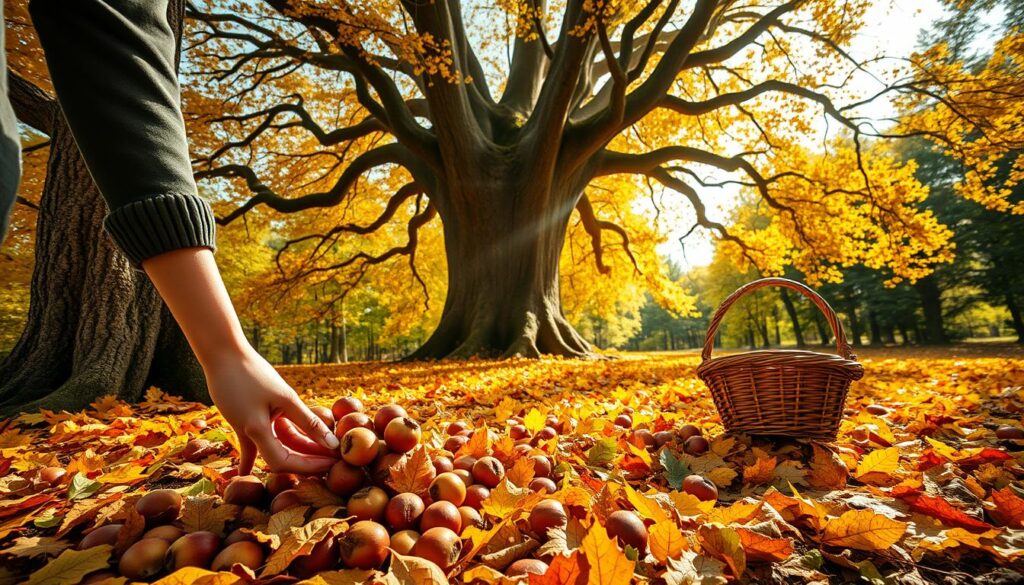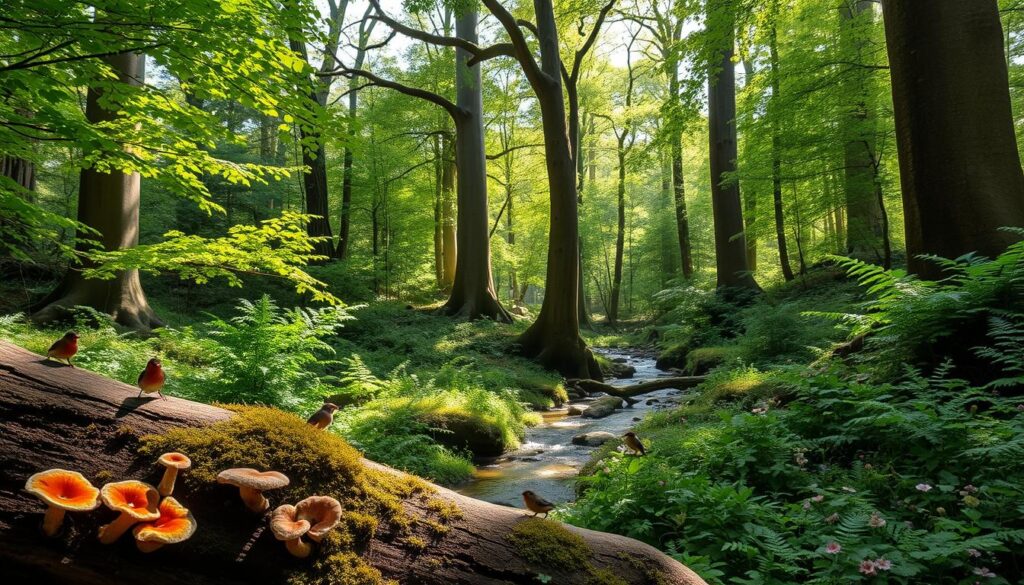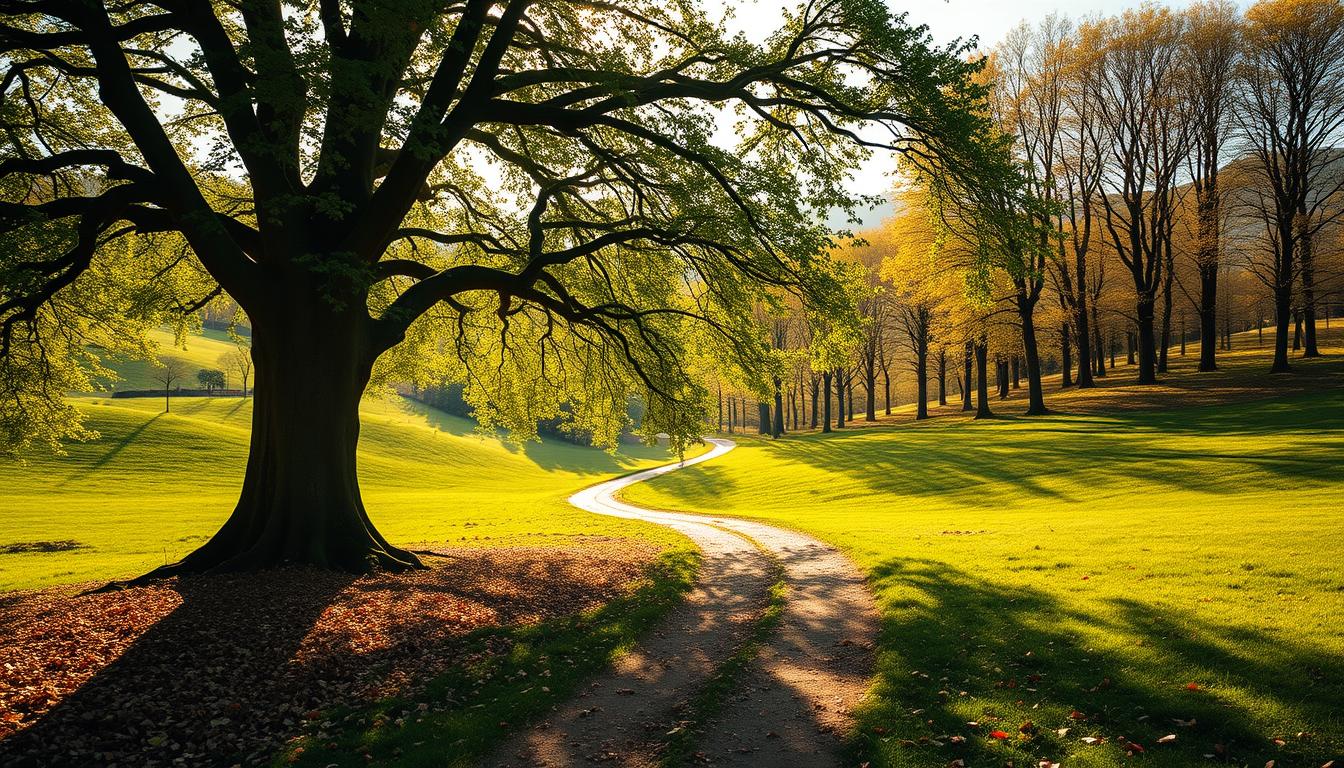Every homeowner wants a yard that’s beautiful, shaded, and good for the environment. The beech nut tree, or Fagus grandifolia, is a great choice. It’s not just pretty; it also helps wildlife, saves energy, and keeps the environment healthy.
Planting a beech nut tree is more than just decorating your yard. It turns your backyard into a living space for animals and a beautiful sight for years. The American beech is a wonderful addition to any home with its smooth bark and nutritious nuts.
Table of Contents
Understanding the American Beech Tree Species
The American beech (Fagus grandifolia) is a majestic native tree. It captures the essence of North American forests. This species offers a fascinating glimpse into the eastern United States’ natural landscape.
Beech tree identification becomes easier when you understand its unique characteristics. These trees are known for their distinctive features that set them apart in woodland environments.
Native Habitat and Distribution
You’ll find the American beech thriving in specific ecological zones across North America. The tree’s natural range includes:
- Northeast United States
- Southeastern Canada
- Appalachian Mountain regions
- Parts of the southeastern United States
Physical Characteristics of Fagus Grandifolia
Recognizing a fagus grandifolia involves observing several key physical traits:
- Bark: Smooth, light gray bark that remains remarkably consistent throughout the tree’s life
- Leaves: Oval-shaped with prominent veins and serrated edges
- Size: Can reach heights of 50-80 feet at full maturity
Growth Patterns and Lifespan
American beech trees are slow-growing but incredibly long-lived. They can survive for 300-400 years under optimal conditions. This makes them true veterans of the forest ecosystem. Their growth is most robust in well-drained, rich soils with partial shade.
Nature’s patience is perfectly embodied in the majestic American beech tree.
The Natural Beauty of Beech Tree Bark
Beech tree bark is a true marvel of nature. Its smooth, silvery-gray surface is breathtaking. It makes these trees stand out in the forest.
Identifying beech trees is easy thanks to their bark. Unlike many trees, beech bark stays smooth forever. This makes them easily recognizable in the wild.
- Smooth, light gray exterior that remains consistent
- Sleek surface without deep ridges or extensive texture
- Reflective quality that changes subtly with different lighting
The bark’s beauty is more than skin deep. Naturalists and forest enthusiasts often marvel at how the beech tree bark seems to capture light, creating a nearly luminescent quality in woodland environments. It’s not just pretty; it’s also a key way to identify trees in the forest.
“In the language of trees, beech bark speaks of elegance and timeless beauty.” – Forest Botanist
While the bark is tempting to carve, it’s important to leave it alone. Each mark tells a story of growth and beauty. It’s a reminder of nature’s artistry that we should cherish.
How to Successfully Plant a Beech Nut Tree
Planting a beech nut tree can change your yard into a beautiful place. It’s ideal for both seasoned gardeners and beginners alike. Knowing the right steps will help your beech trees grow well.
To make sure your beech trees grow strong, you need to think about a few important things. Let’s look at the key steps to help your beech nut tree grow healthy and strong.
Preparing the Perfect Soil Environment
Beech trees need special soil to grow well. They do best in:
- Well-drained, slightly acidic soil (pH between 5.5 and 6.5)
- Rich, organic soil with good nutrients
- Loamy soil texture for better root growth
Sunlight and Placement Strategies
The place you choose for your beech nut tree is very important. These trees can handle some shade but do best in:
- Full sun to partial shade
- A minimum of 4 to 6 hours of direct sunlight per day.
- Protection from too much heat in the afternoon
Strategic Spacing for Optimal Growth
When picking a spot for your beech trees, think about how big they’ll get. Here are some spacing tips:
- 20-30 feet between each beech tree
- 50-60 feet from buildings
- Keep them away from underground utilities and power lines
By following these tips, you’ll make a great spot for your beech nut tree. It will grow strong roots and become a beautiful part of your landscape.
Harvesting and Using Edible Beech Nuts

Beech nuts are a fascinating addition to your foraging repertoire. These small, triangular edible tree nuts offer a unique culinary experience for adventurous food enthusiasts. When harvested at the right time, they provide a rich, slightly sweet flavor that can elevate many recipes.
The best time to collect beech nuts is in early autumn when the spiky husks begin to split open. You’ll want to gather them quickly before wildlife claims their share. Follow these steps for successful harvesting:
- Wait until nuts fall naturally from the tree
- Collect nuts from the ground using gloves
- Remove the outer prickly husk carefully
- Inspect nuts for quality and discard any damaged specimens
Beech nuts nutrition is impressive. These tiny kernels are packed with essential nutrients, including:
- Healthy fats
- Protein
- Minerals like magnesium and zinc
- Antioxidants
To prepare beech nuts for consumption, you’ll need to roast them. Spread the nuts on a baking sheet and roast at 350°F for about 15 minutes. This process enhances their flavor and makes them easier to crack open. You can enjoy them as a snack, grind them into flour, or use them in baking and cooking.
Remember to practice sustainable harvesting. Leave some nuts for local wildlife, ensuring a balanced ecosystem around your beech tree.
Beech Trees as Natural Shade Providers
Planting beech trees around your home can make your outdoor space cooler and more energy-efficient. These trees do more than look good – they help control the climate. This makes your home more comfortable and can lower your energy bills.
Beech trees are great at providing shade with their dense canopies. Their wide leaves act like an umbrella. They block strong sunlight and lower the temperature around your home.
Cooling Benefits for Your Home
Placing beech trees in the right spots can cool your home a lot. These trees work like natural air conditioners. They cool your area in several ways:
- They block direct sunlight from hitting your home’s exterior.
- They lower surface and air temperatures through leaf transpiration.
- They create shaded areas that absorb less heat.
Energy Cost Reduction Potential
Using the shade from beech trees can cut your cooling costs. Here’s how much you might save:
| Tree Placement | Potential Energy Savings | Temperature Reduction |
|---|---|---|
| South-facing placement | Up to 30% cooling cost reduction | 5-10 degrees Fahrenheit |
| West-facing placement | Up to 40% cooling cost reduction | 8-15 degrees Fahrenheit |
Pro tip: Beech trees lose their leaves in winter. This lets sunlight warm your home during cold months. They’re a smart choice for energy savings all year.
Wildlife Benefits of Beech Woodlands

Beech woodlands are key to supporting many wildlife species. These forests offer more than just beauty. They are vital habitats for many animals. The dense canopy and complex root systems of beech trees create a perfect home for wildlife.
The nuts from these trees are a big food source for animals. Small mammals and birds eat these nuts when food is scarce. Many animals benefit from these woodlands:
- Squirrels gathering nuts for winter storage
- Chipmunks foraging on the forest floor
- Birds nesting in the sturdy branches
- Black bears seeking nutrition before hibernation
Beech woodlands are not just about food. They also offer shelter and nesting sites. Woodpeckers, owls, and small songbirds frequently make their homes within the protective branches of mature beech trees. This complex ecosystem supports many life forms and helps keep biodiversity high.
“A single beech tree can support hundreds of different life forms, making it a keystone species in forest ecosystems.” – Wildlife Conservation Expert
By protecting beech tree forests, we help preserve wildlife habitats. Each beech woodland is a complex system that supports many species. It’s essential for their survival.
Maintenance Tips for Healthy Beech Trees
To keep your beech trees healthy, you need to care for them. Proper care makes these trees stay vibrant and beautiful for a long time. Knowing what beech trees need helps protect your investment and enjoy their beauty for years.
Pruning Guidelines for Optimal Tree Health
Pruning beech trees needs to be done right and at the right time. The best time is late winter or early spring before new growth starts. Remove:
- Dead or damaged branches
- Crossing limbs that rub against each other
- Branches showing signs of disease
Preventing Common Beech Tree Diseases
Stopping diseases before they start is key to keeping beech trees healthy. Look out for these common problems:
| Disease | Symptoms | Prevention Strategy |
|---|---|---|
| Beech Bark Disease | Bark damage, white woolly patches | Regular inspection, avoid wound stress |
| Leaf Spot | Brown or black spots on leaves | Ensure proper air circulation |
Seasonal Care Requirements
Each season has its challenges for beech trees. Consistent monitoring and targeted care keep them strong:
- Spring: Mulch around the base, and check for winter damage
- Summer: Deep watering during dry periods
- Fall: Rake fallen leaves, inspect root zone
- Winter: Protect from harsh winds, avoid salt damage
“A well-maintained beech tree is a living testament to careful stewardship and natural beauty.” – Arborist Expert
By following these care tips, your beech trees will stay beautiful and healthy for many years.
Environmental Impact of Beech Tree Forests
Beech tree forests are key to keeping our environment healthy. By planting beech trees or saving existing woodlands, you help a vital ecosystem. This ecosystem brings many benefits to our planet.
Beyond their beauty, beech forests are crucial for our planet. They soak up a lot of carbon dioxide, helping fight climate change. A full-grown beech forest can take in thousands of pounds of carbon each year. This makes them vital in the battle against global warming.
- Carbon sequestration capabilities of beech tree forests
- Soil conservation and erosion prevention
- Water cycle regulation
- Biodiversity support
Beech woodlands are also important for soil and water. Their roots keep the soil stable, stop erosion, and help water soak in. This underground network keeps moisture and nutrients, supporting life under the forest.
Local beech tree forests are homes for many animals. They offer shelter, food, and places to breed. By protecting these forests, you help many species and keep our ecosystem strong.
“Forests are the lungs of our planet, and beech woodlands are extraordinary contributors to environmental health.” – Environmental Conservation Expert
Knowing how beech tree forests help us encourages better care for the land. Whether you have a few trees or plan green spaces, every effort helps. Together, we can save these precious ecological treasures.
Landscape Design Ideas with Beech Trees
Using beech trees in your outdoor space opens up a world of creative possibilities. These trees are not just beautiful; they also offer practical solutions for your yard. Whether you want a private spot or a beautiful yard, beech trees can help.
Creating Natural Privacy Screens
Beech trees are great for creating privacy. Their thick leaves and tall stature make them perfect for hiding your view. Here are some tips for using beech trees for privacy:
- Plant in staggered rows for maximum coverage
- Choose American beech varieties with tight branching patterns
- Space trees approximately 10-15 feet apart
- Select locations with adequate sunlight and well-draining soil
Complementary Plant Combinations
Pairing beech trees with other plants can make your landscape even more beautiful. The right plants can add color and texture, making your yard a true work of art.
| Plant Type | Compatibility with Beech Trees | Aesthetic Impact |
|---|---|---|
| Shade-loving Ferns | Excellent | Soft understory texture |
| Woodland Wildflowers | Very Good | Seasonal color variation |
| Evergreen Shrubs | Good | Year-round structure |
Think about layering your landscape with beech trees. Use them as the main attraction or as a backdrop. This way, you can create outdoor spaces that truly show off your style.
Conclusion
Planting a beech nut tree in your yard makes it vibrant and sustainable. These trees do more than look good. They provide cool shade in summer and help local wildlife.
Choosing beech trees for your yard has many benefits. They create beautiful landscapes and save energy. Plus, they grow well in many soils, fitting into various designs across the U.S.
By picking a beech nut tree, you’re improving your property and helping nature. Each tree shows how amazing nature can be. It grows, adapts, and connects everything around it.
Your yard can become a sanctuary with the right beech tree. They offer shade, support wildlife, and add beauty. These trees are a great choice for a lasting natural legacy.
FAQ
What is a beech nut tree?
A beech nut tree, also known as Fagus grandifolia, is a native North American tree. It has smooth, silvery-gray bark and edible nuts. It’s found in eastern United States forests and is valued for its beauty and ecological importance.
How long do beech trees live?
Beech trees can live up to 300-400 years. Their slow growth and strong nature make them long-lasting in landscapes and forests.
Are beech nuts edible for humans?
Yes, beech nuts are edible and nutritious. They have healthy fats, proteins, and minerals. But, they can taste slightly bitter raw. You can roast them or grind them into flour after preparation.
What wildlife benefits do beech trees provide?
Beech trees are vital for wildlife. They provide both food and shelter for numerous species. Their nuts are a key food source for squirrels, chipmunks, birds, and bears. The tree’s dense canopy also provides nesting sites for birds and small mammals.
What are the ideal conditions for growing beech trees?
Beech trees do best in well-drained, slightly acidic soils. They need full sun to partial shade. They thrive in cool, moist environments, typical of northeastern United States forests.
How do I identify a beech tree?
Identify a beech tree by its smooth, light gray bark. It has broad, elliptical leaves with prominent veins. It also produces small, triangular nuts in autumn.
Can beech trees help reduce home energy costs?
Yes, beech trees can lower home energy costs. Their dense canopy shades your home in summer. This can reduce air conditioning needs and cool your home naturally.
How often should I prune a beech tree?
Prune beech trees lightly and carefully. Prune in late winter or early spring before new growth begins. Remove dead, damaged, or crossing branches to keep the tree healthy and shaped.
Are there any common diseases that affect beech trees?
Beech trees can get beech bark disease and beech leaf disease. They can also get root rot. Regular checks, proper spacing, and tree health care can prevent these diseases.
How do beech trees contribute to environmental conservation?
Beech trees help the environment by sequestering carbon and preventing soil erosion. They support biodiversity. Their extensive root systems stabilize soil, and their forests are crucial habitats for many species.

